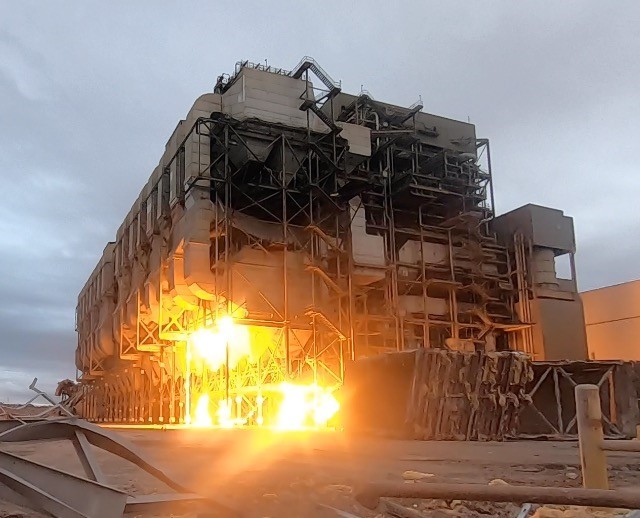NGS Precipitators Demolished
Dynamite blasts drop NGS Units 1 & 2 precips in 7 seconds
Under Tuesday’s dark, wintry dawn sky, the massive NGS Units 1 and 2 electrostatic precipitators rolled to the ground in another flawless blast.
In just two seconds, steel beams supporting the precips were sliced through like a laser by 110 brilliant, sequential dynamite detonations. Five seconds later, the fly ash collectors were laying on the ground in mountains of twisted metal.
Three minutes before the explosion, Dykon Blasting CFO Steve Hatch instructed Julie Elliott, SRP Major Projects Contracts Manager, and Roseanna Navarro, SRP Rotational Engineer, to compress the two fire buttons simultaneously. Gary Barras, SRP Director of Special Projects, surprised them with the distinction of setting off the blast.
“When we drove up here, Gary said, ‘Oh, by the way, Julie, you’ve got to get dressed because you’re going to come do this,” Elliott said.
Next came the marine horn three-minute warning.
“Your go-code will be, ‘Light it up, ladies,” Ron Gilbert, Dykon’s Vice President of Operations, told the women.
After the one-minute warning came the countdown and call from Gilbert — “Fire in the hole!” — followed by the go-code to blast away.
“It was awesome,” Navarro said. “I didn’t think we’d have that opportunity.”
It was over within seconds except for the cleanup that will take a week or two. The Unit 3 precip was demolished a month ago when the three 775-foot stacks were felled like trees.
To prepare for today’s blast, hundreds of V-shaped torch cuts had to be made at the base of the steel support beams, or “stumps,” and high up to separate the 203-foot-tall precipitator infrastructure at all points it connected to the adjoining 21-story boiler infrastructure.
There could be no place where the falling precipitators might have a “sticker” — something as small as a bolt head — that could catch and pull the boilers down with the precips or cause the precips to not fall as they were supposed to. Instead, the separation was perfect, allowing the huge structure to rotate, collapse and fall into the area where the three huge stacks once stood.
These hot-side electrostatic precipitators were original to NGS. For 45 years, they removed 99.5% of fine fly ash from the flue gas before it could be discharged from the stacks.
Next on the schedule is demolition of the similarly huge boilers that created the steam to turn the NGS turbines.
“The really exciting part of all this is restoring the land and returning it after 50 years of all this effort and all this industrial use,” Elliott said. “To restore it to nature, that’s the best part.”

